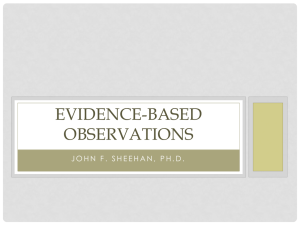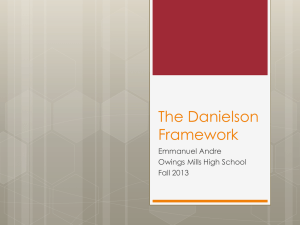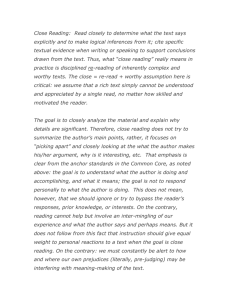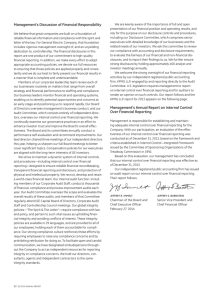Course Description - Brandeis University
advertisement
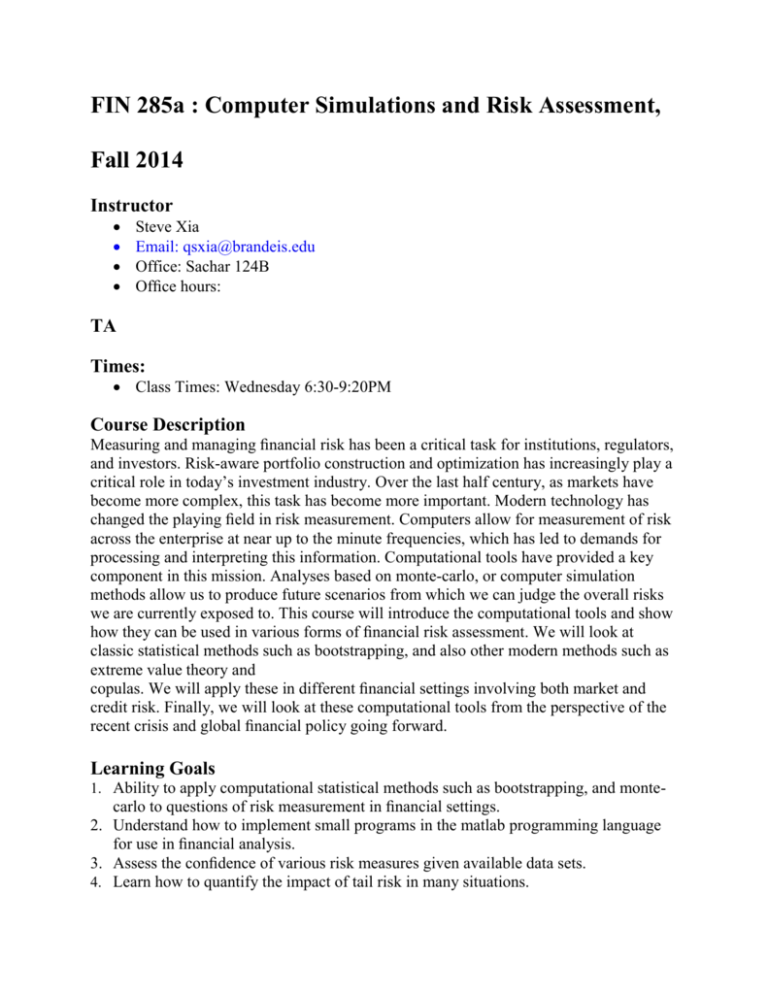
FIN 285a : Computer Simulations and Risk Assessment, Fall 2014 Instructor Steve Xia Email: qsxia@brandeis.edu Office: Sachar 124B Office hours: TA Times: Class Times: Wednesday 6:30-9:20PM Course Description Measuring and managing financial risk has been a critical task for institutions, regulators, and investors. Risk-aware portfolio construction and optimization has increasingly play a critical role in today’s investment industry. Over the last half century, as markets have become more complex, this task has become more important. Modern technology has changed the playing field in risk measurement. Computers allow for measurement of risk across the enterprise at near up to the minute frequencies, which has led to demands for processing and interpreting this information. Computational tools have provided a key component in this mission. Analyses based on monte-carlo, or computer simulation methods allow us to produce future scenarios from which we can judge the overall risks we are currently exposed to. This course will introduce the computational tools and show how they can be used in various forms of financial risk assessment. We will look at classic statistical methods such as bootstrapping, and also other modern methods such as extreme value theory and copulas. We will apply these in different financial settings involving both market and credit risk. Finally, we will look at these computational tools from the perspective of the recent crisis and global financial policy going forward. Learning Goals 1. Ability to apply computational statistical methods such as bootstrapping, and monte- carlo to questions of risk measurement in financial settings. 2. Understand how to implement small programs in the matlab programming language for use in financial analysis. 3. Assess the confidence of various risk measures given available data sets. 4. Learn how to quantify the impact of tail risk in many situations. 5. This course can be a rough preparation (with some more reading) for taking the financial risk manager (FRM) exam from the Global Association of Risk Professionals (GARP). Prerequisites 1. FIN 201a, or a basic knowledge of finance is essential. 2. Econ210f/Econ211f or Econ184a: Finally, a basic working knowledge of mathematical statistics is important too. You need to know about random variables, probability distributions and densities. Also, a little knowledge of linear regression will be useful too. A standard one semester course in math stats with calculus will cover this. 3. Fin 270a (Options and derivatives) would also be useful, but it is not required. 4. Although computer skills will be taught in the course, some enthusiasm for programming will be useful. 5. The course also assumes basic calculus equivalent to about 1 semester of calculus at the undergraduate level. This course is designed for 2nd year IBS masters students (MA, MSF, MBAi). PhD students may also find some of the content useful as well. Required Readings: 1. Danielsson, Financial Risk Forecasting, Wiley, 2011. 2. Patrick Herb, Matlab web guide 3. Griffiths, Matlab Lecture Notes. Very useful recommended books: 1. Malz, Financial Risk Management:Models, History, and Institutions, Wiley, 2012. 2. Christoffersen, Elements of Financial Risk Management, Second edition, Academic Press, 2012. 3. Hull, Risk Management and Financial Institutions, Third edition, Wiley 2012. Other useful readings: 1. Miller, Michael B., Mathematics and Statistics for Financial Risk Management, Wiley, 2012. 2. Hanselman and Littlefield, Mastering Matlab 7, Prentice Hall. Required Software Matlab programming language. Matlab is available on all the IBS computers. Also, our license will enable you to load one copy of matlab (and key toolboxes) on your own computer. Info will be emailed to you on this. Grading Grades will be based on problem sets (15%), a midterm exam (35%), a group project (15%), and a final exam (35%). Communications You are responsible for all announcements and materials in class. Also, much of the information in class will be sent over Latte and the class website. Rules specific to Fin285 1) Exams a) Your own work. b) Closed book (no notes) c) No laptops, no cell phones, no pda's. 2) Problem sets a) Hand in your own work. b) Can talk and assist each other. c) Use all resources 3) Group projects a) Own work for the group. b) Hand in one writeup per group. 4) Laptops: Please bring to class if you want to Academic Honesty You are expected to be familiar with and to follow the University's policies on academic integrity (see http://www.brandeis.edu/studentlife/sdc/ai/). Instances of alleged dishonesty will be forwarded to the Office of Campus Life for possible referral to the Student Judicial System. Potential sanctions include failure in the course and suspension from the University. Disability Statement If you are a student with a documented disability on record at Brandeis University and wish to have a reasonable accommodation made for you in this class, please see me immediately. Course Outline 1. Introduction 2. Tools a. The Matlab computer language (Danielson, appendix C) b. Statistical tools and the financial bootstrap toolbox: i. Probability basics ii. Sampling, monte-carlo, and bootstrapping (Cosma Salizi, The Bootstrap, American Scientist) iii. Hypothesis tests (Danielson, A7) iv. Time series basics (Danielson A5) 3. Financial data review a. Financial data reminder/review (Danielson, 1.1-1.2) b. Stylized facts of financial data (Danielson, 1.3-1.7) 4. VaR analytics (Danielson, 4.1-4.4) a. Basics and interpretations b. VaR issues c. Expected shortfall (Danielson, 4.5) 5. Estimating VaR (Danielson, 5.1-5.3, 7.1,7.3.1) a. Parametric methods b. Historical VaR c. The bootstrap. monte-carlo, and VaR precision d. The antithetic bootstrap e. Method comparisons 6. Extending VaR a. Time aggregation and longer horizons (Danielson, 4.6, 5.4) b. Extreme value theory (Danielson, 9) 7. Volatility forecasting a. Modeling volatility (Danielson, 2.1-2.3, 2.7-2.8) b. Using volatility forecasts (Danielson, 5.5) i. ii. iii. iv. Basic empirical conditional volatility Implied volatility and VIX Realized volatility Time series models, and volatility forecasting c. The volatility term structure (Chistoffersen, chapter 8) 8. Correlations and portfolios a. Correlations and portfolios (Danielson, 7.4) b. Simple multivariate models with changing correlations (Christoffersen, chapter 7.1-7.3) c. Portfolio mapping and factors (Malz, chapter 5 (skim) ) d. Copulas (Danielson, 1.8, Christoffersen 9) 9. Fixed income securities and simple option portfolios (Danielson, 7.2-7.3, light skim 6) a. Bond and option pricing with simulation b. Options and partial risk hedges 10. Path dependence and the dynamics of risk a. Exotic options (Barriers and Asian) b. Convergence trades and pairs trading (Funding risk) (Malz, chapter 12 (skim)) c. Carry trades d. Momentum and other dynamic trading strategies e. Retirement portfolios 11. Backtesting/stress testing (Danielson, 8, Christoffersen 13 , Malz 13.3) a. Backtests and VaR evaluation b. Capital requirements and VaR (Hull, chapter 12(skim), 13.1/13.2) c. Stress tests (Hull, chapter 19) d. Model risk (Malz, chapter 11.1) 12. Financial crises and risk dynamics (Malz, 14) a. Liquidity risk b. Currency crisis c. High frequency trading d. Network connections e. Bubbles f. Forecasting financial crises 13. Risk and regulation: Summary, dangers, and crisis perspectives (Danielson, 10 (skim) )



